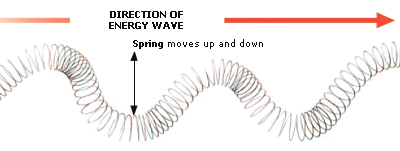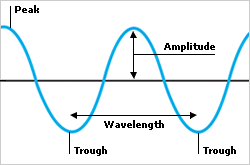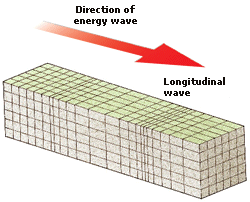DK Science: Energy Waves
Many different kinds of energy travel in waves. Sound waves carry noises through the air to our ears. SEISMIC WAVES travel inside the Earth and cause earthquakes. Light, heat, radio, and similar types of energy are carried by a variety of waves in the ELECTROMAGNETIC SPECTRUM. Some energy waves need a medium, such as water or air, through which to travel. The medium moves back and forth as waves carry energy through it, but it does not actually travel along with the wave.

Suppose you fix a slinky spring at one end and push the other end back and forth. Some parts of the spring, called compressions, are squeezed together. Other parts of the spring, called rarefactions, are stretched out. The compressions and rarefactions travel down the spring carrying energy. This type of wave is called a longitudinal or compression wave.

Suppose you fix the slinky at one end and move it up and down. Energy travels along the spring’s length in S-shaped waves, so the forward direction in which the energy moves is at right angles (or transverse) to the up-and-down direction of the movement of the spring. This is called a transverse wave.

Waves have three important measurements. The amplitude is the height of a peak or trough. The wavelength is the distance between any two peaks or troughs. The frequency is the number of waves that pass by in one second. Amplitude and wavelength are measured in metres. Frequency is measured in hertz (Hz). One Hz is equal to one wave passing by each second.
When an ocean wave crashes against the shore, it releases a large amount of energy. Ocean waves are transverse waves that carry huge amounts of energy across the surface of the sea as they move up and down. A wave 3 m (10ft) high carries enough energy to power around 1,000 lightbulbs in every 1 m (3 ft) of its length.
In 1887, physicist Heinrich Hertz became the first person to prove that waves carry electromagnetic energy between two places. This extremely important finding eventually led to the development of radio and television. Hertz did not live to see these inventions, however. He died in 1894, aged only 36.
Radios, televisions, mobile phones, and radar use signals made up of electromagnetic waves. These are waves that carry energy as electricity and magnetism at the speed of light. Light we can see is also an electromagnetic wave, but other types of electromagnetic wave are invisible. The various types of electromagnetic wave have different frequencies and wavelengths. Together, they make up the electromagnetic spectrum.

X-rays are high-energy waves that pass through flesh but not bone. In medicine, X-ray photographs are used to check people's bones for damage. In high doses, X-rays can harm people.
These are produced by radioactivity. They have a short wavelength and a high frequency and carry large amounts of energy. They are very harmful and can cause cancer in humans and animals.
These invisible waves are slightly shorter than visible violet light and carry more energy. We wear sunglasses and sunblock to prevent damage to our eyes and skin by ultraviolet rays.
Infrared rays are slightly longer waves than visible red light. Although we cannot see infrared, we can feel it as heat. When heat energy is transferred by radiation, it is carried by waves of infrared.
Radar is a way of locating aeroplanes and ships using a type of radio waves called microwaves. These have much longer wavelengths than visible light. Cooking is another use for microwaves.
When the energy stored in rock deep inside the Earth is suddenly released, it travels up to the Earth’s surface in huge seismic shock waves. The waves move along weaknesses in the rock known as faults. As they do so, they produce violent shaking of the ground and an earthquake. The largest earthquakes can release as much energy as a small atomic bomb.

Some seismic waves are longitudinal or compression waves called primary or P-waves. They cause damage by pushing and pulling things back and forth in the same direction that the wave travels. P-waves move extremely quickly through the Earth’s interior at a speed of about 25,000 kph (15,500 mph).
